#mycology
Text
Okay. This is a pretty big deal in the world of mycology. Historically fungi have been divided up into either parasites that siphon resources from plants, mutualists that cooperate with them, or saprotrophs that break down decaying organic matter (plant and otherwise.) The genus in question, Mycena, has traditionally been made of saprotrophic species feeding on decaying wood.
However, what scientists are observing is Mycena fungi displaying primitive mutualistic behaviors, specifically providing living plants with nitrogen and getting carbon in return from a living partner, or getting to chow down on the plant's remains once deceased. This shows a significant level of adaptability that hasn't been observed in fungi beforehand, though given how much we don't know about fungi there's a good possibility this isn't an unprecedented event.
It doesn't surprise me one bit that we're seeing this in Mycena. These fungi are especially opportunistic; in fact, that mushroom growing out of a frog's skin that we saw a while back was also a Mycena species. Perhaps we need to add bonnet mushrooms to raccoons, dandelions, and other hardy generalists as symbols of scrappy survival in spite of environmental pressures.
#Mycena#bonnet mushrooms#mushrooms#mushroom#fungi#fungus#mycelium#mycology#botany#biology#nature#science#scicomm#evolution#environment#ecology#mutualism#mycorrhizal fungi
161 notes
·
View notes
Text


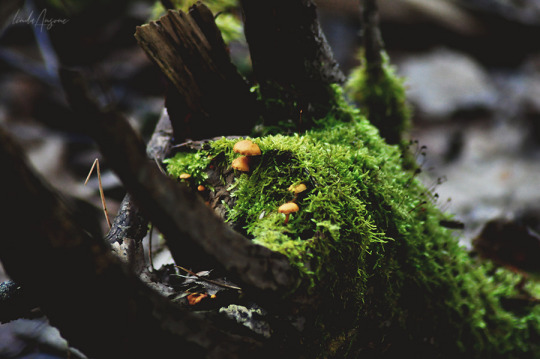



#mushrooms#fungi#moss#mycology#mushroom photography#woods#forest floor#forestcore#goblincore#nature#nature photography#naturecore#original photographers#photographers on tumblr
34 notes
·
View notes
Text

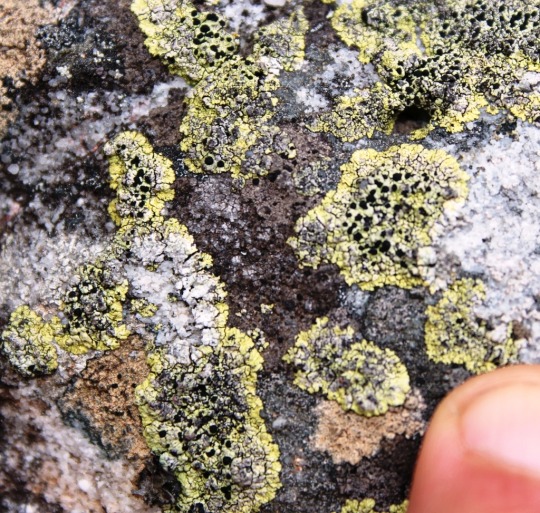

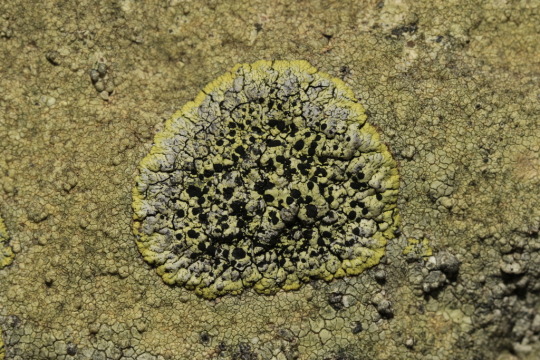
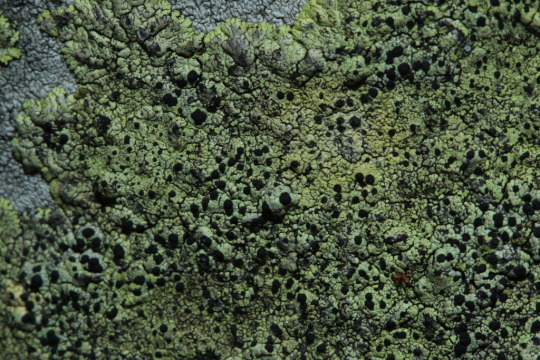


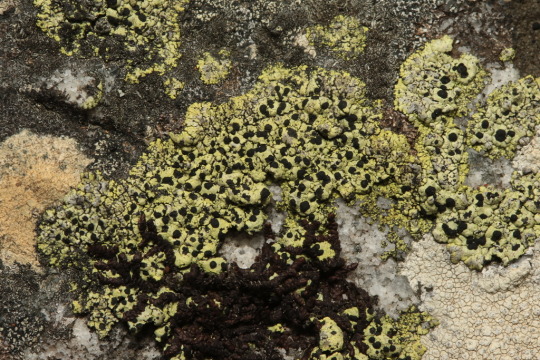
Diploicia africana
This crustose-placodioid lichen grows in yellow rosettes on siliceous, rock in South Africa. The upper surface is often bleached and wrinkled toward the center of the rosette, and speckled with black, lecideine apothecia. Being that D. africana is a) crustose b) saxicolous and c) endemic to the southern hemisphere, it shouldn't be surprising that this lichen appears to be largely understudied, and it might be more widespread than currently recognized.
images: source
info: source
#lichen#lichens#lichenology#lichenologist#mycology#ecology#biology#fungi#fungus#symbiosis#symbiotic organisms#algae#life science#environmental science#natural science#nature#the natural world#Diploicia africana#Diploicia#trypo#trypophobia#I'm lichen it#lichen a day#daily lichen post#lichen subscribe
53 notes
·
View notes
Text
Just so everyone is aware:
An international group of qualified mushroom identifiers who do worldwide identification in emergency cases have identified the Shroomers App as a potentially very dangerous system that could kill you if you try to use it to identify edible mushrooms. They use AI to generate almost all of their content, including their identification profiles on their app as well as their books and other materials. Not only is this unethical from a content creation standpoint, it is also extremely dangerous.
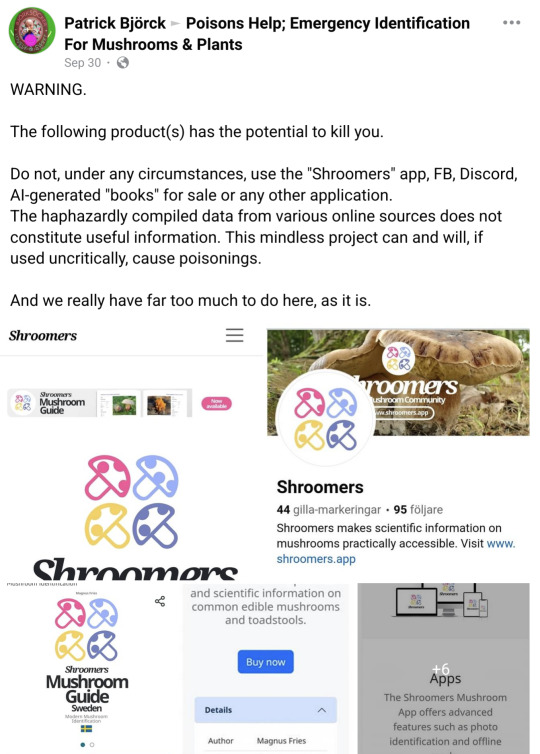
DO NOT USE APPS FOR IDENTIFICATION PURPOSES BEYOND SIMPLE CURIOSITY. A MISTAKE WHEN IDENTIFYING AN EDIBLE COULD COST YOU YOUR LIFE. DO NOT EAT ANY FORAGED MUSHROOM YOU CANNOT IDENTIFY YOURSELF BY SIGHT OR HAS BEEN IDENTIFIED IN PERSON BY SOMEONE WHO CAN.
ONLY BUY BOOKS FROM REPUTABLE SOURCES AND AT THIS POINT THAT MEANS ASKING EXPERIENCED PEOPLE WHAT BOOKS THEY USE.
Mushrooms are fun, amazing organisms. Enjoy safely.
#mushroom#mushroom identification#mushrooms#fungus#fungi#macrofungi#shrooms#mycology#shroomersapp#shroomers app#shroomers#mycophobia
44K notes
·
View notes
Text
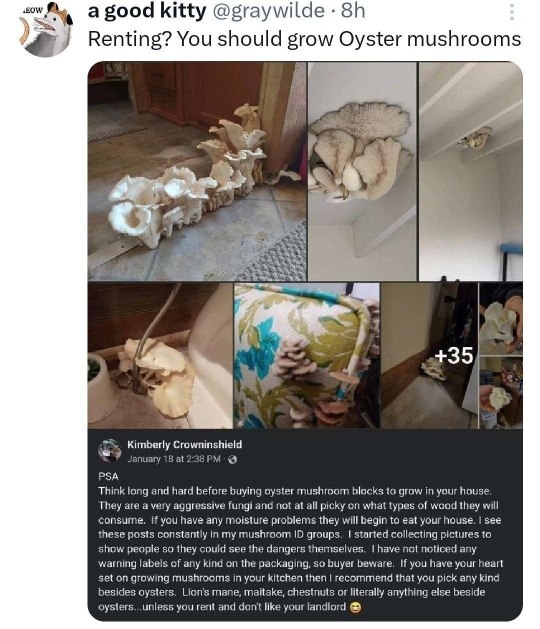
The landlord fears the urban oyster mushroom farmer
23K notes
·
View notes
Text
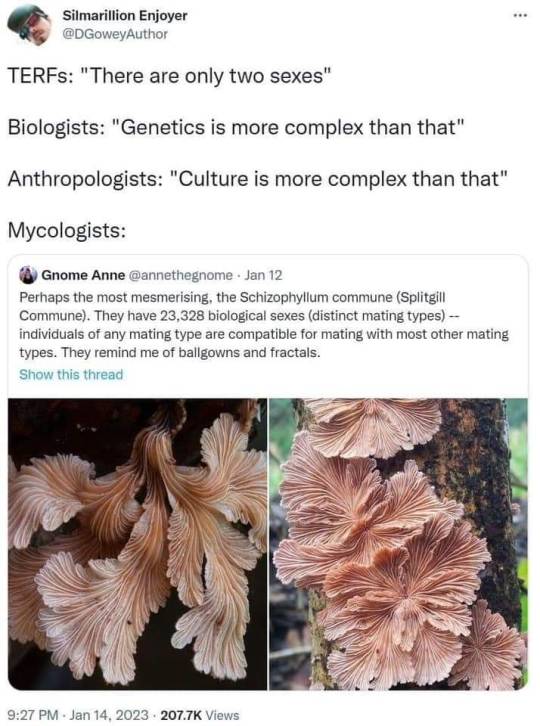
28K notes
·
View notes
Text
Mushrooms releasing spores into the wind. Captured by Paul Stamets
#nature#photography#mushrooms#spores#wind#fungus#fungi#mycology#science#woods#forest#dark#video#videos
19K notes
·
View notes
Text
supervisor at work desperately wants me to try her herbal mushroom coffee and I looked at the insert and it has cordyceps in it ‘for stamina’ and don’t get me wrong I’m sure it’s a normal edible non-parasitic variety but there IS a little part of me that’s like. oh so that’s what they’re calling it now
7K notes
·
View notes
Text
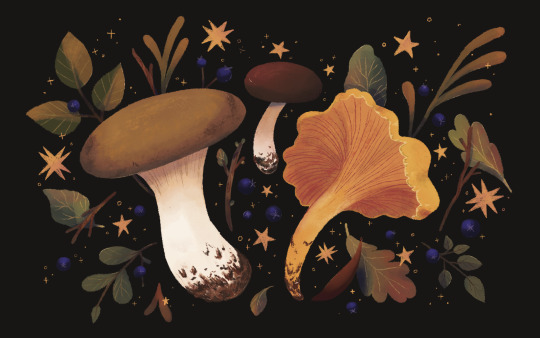
Foraging Finds
#cozy cottage#cottagecore#mushroom#mycology#fungi#goblincore#digital illustration#digital art#illustration#artists on tumblr
5K notes
·
View notes
Text
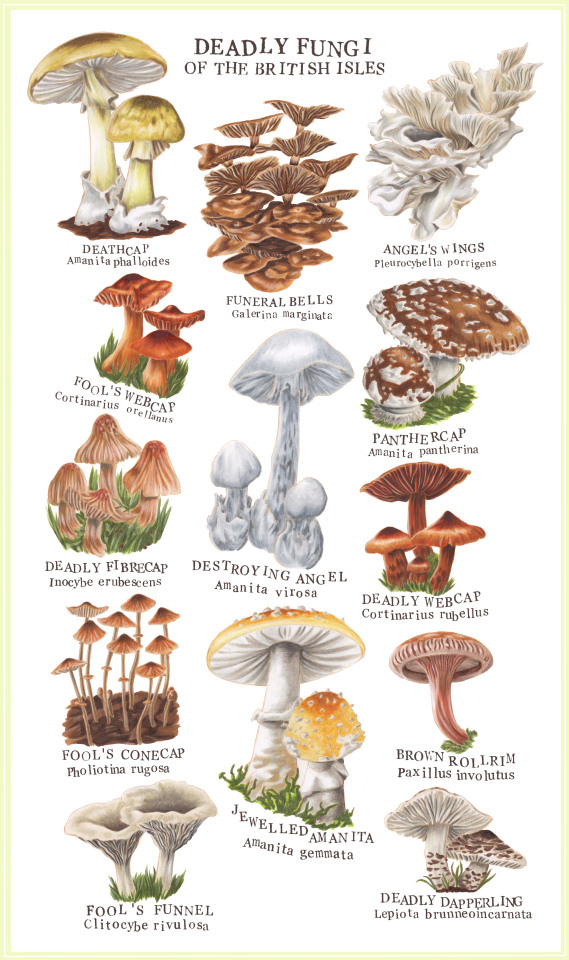
It's fungi season!! Don't eat these, you'll die
#tarot#art#illustration#illustrators on tumblr#illustrators of tumblr#copic#copic markers#ink#fantasy#fantasy art#fantasy illustration#traditional media#traditional illustration#traditional drawing#fungi#mycology#goblincore#cottagecore#fairycore#fungus#storybook#poster#poster art
4K notes
·
View notes
Text
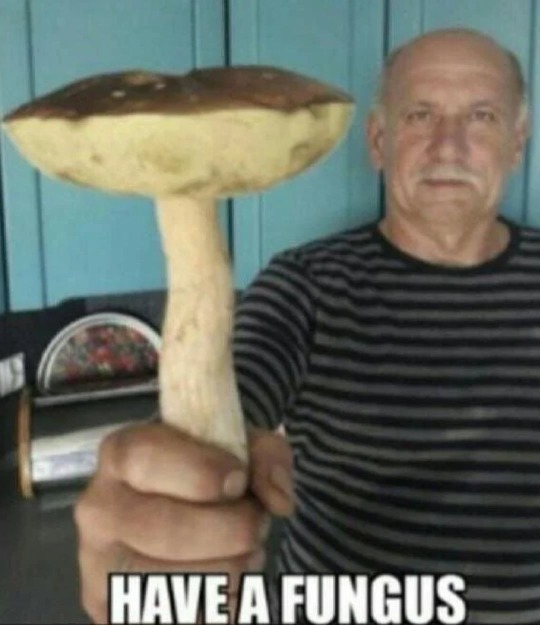
rb to fungus your followers
(they deserve it) (they have been very good)
5K notes
·
View notes
Text

source
#nature#photography#fly agaric#mushrooms#forest#woods#fungus#fungi#mycology#red#nature photography#green#trees#moss
9K notes
·
View notes
Photo
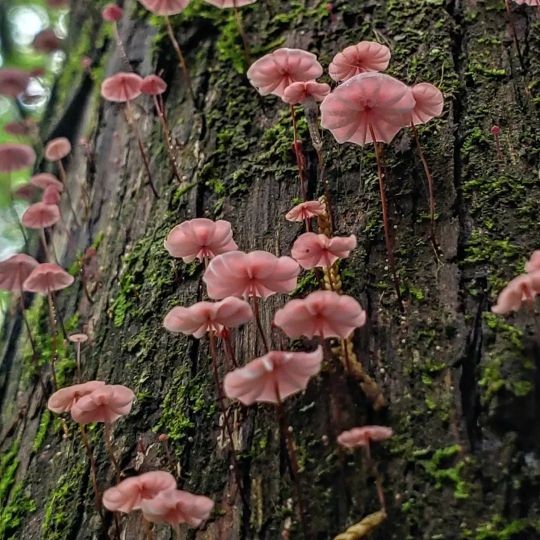
Marasmius Haematocephalus by Leigh Ann Andrews
3K notes
·
View notes
Text
my brother got me this tumbler with a bunch of mushroom/fungus illustrations all over it and it’s the only tumbler I will accept in my life but the designer put one (1) graphic on it that’s actually a thalloid liverwort. no larger than a quarter on the actual product but I see it and I know
#also the tumblr brain rot where my brain goes ‘is that misspelled’ when talking about the hot beverage container#mycology
3K notes
·
View notes
Text
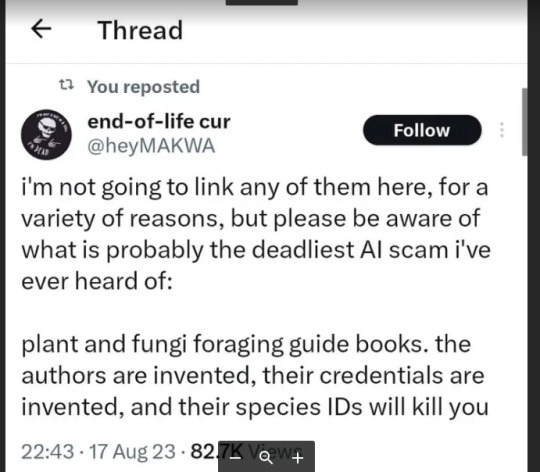
ETA: I wrote up a guide on clues that a foraging book was written by AI here!
[Original Tweet source here.]
[RANT AHEAD]
Okay, yeah. This is a very, very, very bad idea. I understand that there is a certain flavor of techbro who has ABSOLUTELY zero problem with this because "AI is the future, bro", and we're supposed to be reading their articles on how to use AI for side hustles and all that.
I get that ID apps have played into people's tendency to want quick and easy answers to everything (I'm not totally opposed to apps, but please read about how an app does not a Master Naturalist make.) But nature identification is serious stuff, ESPECIALLY when you are trying to identify whether something is safe to eat, handle, etc. You have to be absolutely, completely, 100000% sure of your ID, and then you ALSO have to absolutely verify that it is safely handled and consumed by humans.
As a foraging instructor, I cannot emphasize this enough. My classes, which are intended for a general audience, are very heavy on identification skills for this very reason. I have had (a small subsection of) students complain that I wasn't just spending 2-3 hours listing off bunches of edible plants and fungi, and honestly? They can complain all they want. I am doing MY due diligence to make very sure that the people who take my classes are prepared to go out and start identifying species and then figure out their edibility or lack thereof.
Because it isn't enough to be able to say "Oh, that's a dandelion, and I think this might be an oyster mushroom." It's also not enough to say "Well, such-and-such app says this is Queen Anne's lace and not poison hemlock." You HAVE to have incredibly keen observational skills. You HAVE to be patient enough to take thorough observations and run them through multiple forms of verification (field guides, websites, apps, other foragers/naturalists) to make sure you have a rock-solid identification. And then you ALSO have to be willing to read through multiple sources (NOT just Wikipedia) to determine whether that species is safely consumed by humans, and if so if it needs to be prepared in a particular way or if there are inedible/toxic parts that need to be removed.
AND--this phenomenon of AI-generated crapola emphasizes the fact that in addition to all of the above, you HAVE to have critical thinking skills when it comes to assessing your sources. Just because something is printed on a page doesn't mean it's true. You need to look at the quality of the information being presented. You need to look at the author's sources. You need to compare what this person is saying to other books and resources out there, and make sure there's a consensus.
You also need to look at the author themselves and make absolutely sure they are a real person. Find their website. Find their bio. Find their social media. Find any other manners in which they interact with the world, ESPECIALLY outside of the internet. Contact them. Ask questions. Don't be a jerk about it, because we're just people, but do at least make sure that a book you're interested in buying is by a real person. I guarantee you those of us who are serious about teaching this stuff and who are internet-savvy are going to make it very easy to find who we are (within reason), what we're doing, and why.
Because the OP in that Tweet is absolutely right--people are going to get seriously ill or dead if they try using AI-generated field guides. We have such a wealth of information, both on paper/pixels and in the brains of active, experienced foragers, that we can easily learn from the mistakes of people in the past who got poisoned, and avoid their fate. But it does mean that you MUST have the will and ability to be impeccably thorough in your research--and when in doubt, throw it out.
My inbox is always open. I'm easier caught via email than here, but I will answer. You can always ask me stuff about foraging, about nature identification, etc. And if there's a foraging instructor/author/etc. with a website, chances are they're also going to be more than willing to answer questions. I am happy to direct you to online groups on Facebook and elsewhere where you have a whole slew of people to compare notes with. I want people's foraging to be SAFE and FUN. And AI-generated books aren't the way to make that happen.
#foraging#mushroom foraging#plant foraging#mushrooms#edible plants#edible mushrooms#wild foods#food#nature#AI#fungus#fungi#poisonous mushrooms#poisonous plants#botany#mycology#rant
4K notes
·
View notes
Text
freaky fungi fact - mycology vocab :-)
deliquescence : the process of certain fungi (most often ink caps) where they turn to liquid.
this process is observed in a handful of different fungi !! as their caps mature, they furl inward & turn to a spore-filled, inky liquid.

yes, this liquid can be harvested & used for actual pen ink. :-) just make sure to add preservatives to avoid it causing a rotten smell.

to use it in a sentence : the mushrooms above are experiencing deliquescence ; they are deliquescing !! ink caps are deliquescent.
#• finn's freaky fungi fact ^^ •#||#fungus#fungi#mushroom#mushrooms#mycology#cottagecore#forestcore#foraging#nature#earth#biology#ecology#science#deliquescence
4K notes
·
View notes